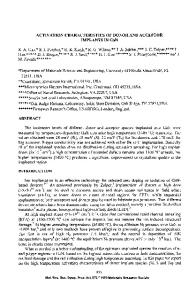Optical Activation Behavior of Ion Implanted Acceptor Species in GaN
- PDF / 107,231 Bytes
- 6 Pages / 612 x 792 pts (letter) Page_size
- 81 Downloads / 316 Views
99W9.8
acceptor activation is difficult because of the inefficient ionization of most acceptors in GaN at room temperature. Our initial study employs the most common acceptor dopant, Mg, in addition to two potentially shallower alternative acceptors, Be and C. We find that the latter two impurities do not activate efficiently without a co-implantation under our conditions, but that Mg does. We also investigate the spectroscopic properties of Zn acceptors, using HVPE material doped with Zn during growth. EXPERIMENTAL APPROACH The starting material for the implantations is a 20 µm thick heteroepitaxial GaN layer grown on sapphire(0001) by hydride vapor phase epitaxy (HVPE). This unintentionally doped layer has a net residual doping level of n=5.1×1016 cm-3 and an electron mobility µn = 680 cm2/Vs. The full width at half maximum (FWHM) of the neutral donor-bound exciton (Do,X) peak in the low temperature PL spectrum of this sample is only 1.8 meV, confirming its good quality. Moreover, the only shallow donoracceptor pair (Do-Ao) PL peak in this sample, at 3.27 eV, is only barely detectable in comparison to the 2LO phonon replica of the (Do,X) peak. The residual yellow and red PL bands at 2.2 and 1.6 eV, respectively, are similarly very weak, having maximum heights at least 5000× smaller than that of the dominant (Do,X) peak. This material is therefore ideal for implantation studies of acceptors, since even very weak peaks due to low dose implants will be readily visible above the residual background peaks. Pieces of the above wafer were implanted with 24Mg, 9Be, or 12C ions, using four different energies in each case to achieve a roughly flat profile from about 20 to 430 nm. The average concentration was set to be 1015, 1016, and 1017 cm-3 in different pieces for each impurity. The samples were then encapsulated with a ~50-70 nm thick layer of AlON, which was reactively sputtered using a high purity Al target, Ar, and N2. The samples were heated to 500 °C during the sputtering process. Rapid post-implantation thermal annealing was then performed for 8 s at 1300 °C in flowing N2. Photoluminescence (PL) spectra were then recorded using excitation provided by a He-Cd laser at 325 nm or by an Ar+ laser at 305.5 nm. Details of the measurement system are given elsewhere [8]. All spectra are corrected for the spectral response of the measurement system. PHOTOLUMINESCENCE OF Mg, Be, AND C IMPLANTED GaN Low temperature PL spectra as a function of implantation dose are shown in Figure 1 for the case of Mg implantation. The highest energy peaks involve donor and acceptorbound excitons and are discussed below. Even at the lowest dose (1015 cm-3), a clear (DoAo) peak at 3.270 eV and its LO and acoustic phonon replicas become visible, although they are more than 100× weaker than the original (Do,X) peak. In contrast, unimplanted control samples annealed under the same conditions show essentially no changes in their spectra (not shown), except for an overall increase in the absolute intensity of the spectrum and a slight broadening
Data Loading...











